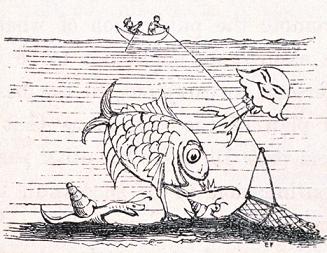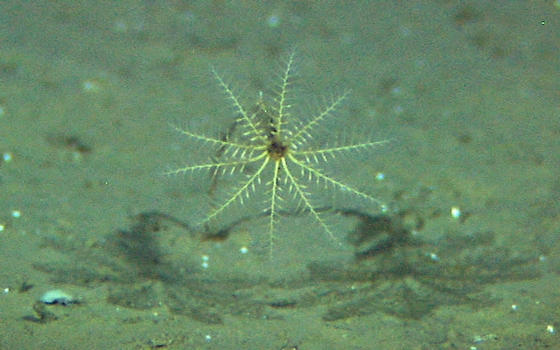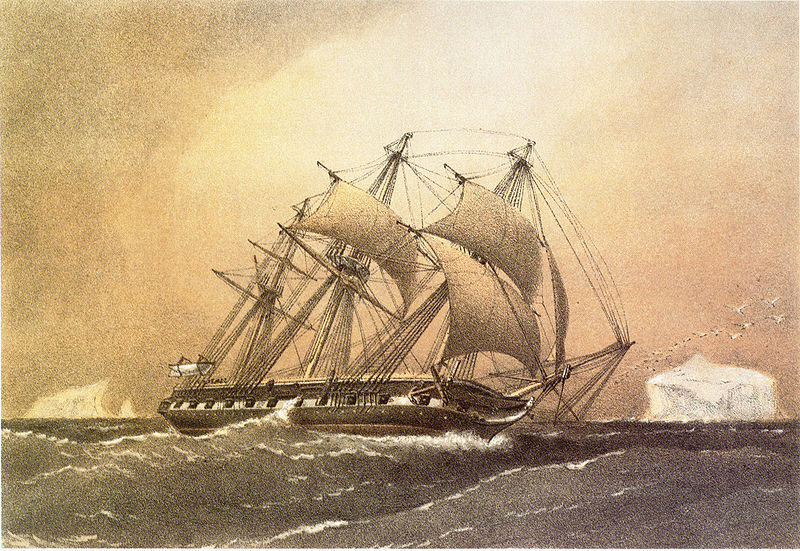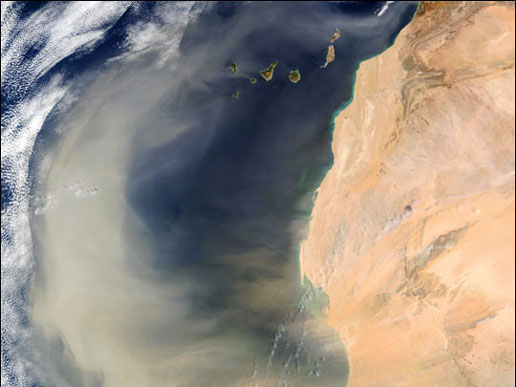If you want to know what the weather is doing you can do as the candlelight fisherman in the song did, and "open the pane and pop out the flame and see how the winds do blow". Or you could look at the nearest weathervane. They come in all sort of designs, shapes and sizes.
The world's biggest is at Whitehorse_International_Airport. It's an old DC3 mounted on a pivot. It takes about a 5 km/hr wind to move it, so it is not the world's most sensitive weathervane.

If you want to know about the weather in older times you have to check the written records. But what to do about the times before written records? What about the geological ages before humans?
The discovery of wind directions from geological materials is a wonderful detective story. To discover facts about the winds that blew in prehistoric times, let us start with a look at the ocean floor. Yes, really.
The modern history of global oceanography starts in 1872 on board HMS Challenger, but there is a very important preface. Until about the 1860s the prevalent scientific opinion was that the depths beyond the continental shelves were lifeless zones. In part, that opinion was due to Edward_Forbes' azoic hypothesis. He failed to find any evidence of life below 300 fathoms in his April 1841 to October 1842 surveys from HMS Beacon in the Aegean Sea. Of course, with hindsight we can say that absence of evidence is not necessarily evidence of absence.

Frontispiece to Edward Forbes's Natural History of the European Seas
Source: Wikimedia, public domain
The Norwegian Michael_Sars had meanwhile been conducting similar surveys. He listed, 1868, 427 animal species caught along the Norwegian coast at depths of 450 fathoms - approx. 820m. Sars described a 'living fossil' - Rhizocrinus lofotensis, the first living stalked crinoid to be described, which his son, G.O. Sars, had found in 1864 at a depth of about 550m in Lofoten.

Rhizocrinus lofotensis below 2000 meters.
Image source: Institute of Marine Research, Nordnes, 5817 Bergen, Norway
http://www.imr.no/
Sars' reports came to the attention of one of Edward Forbes' students: Charles Wyville Thomson. Thomson successfully petitioned the Royal Society and the Admiralty for the funds and a ship to conduct deep-sea dredging studies around Scotland and Ireland. He was granted use of HMS Lightning, a very old paddle steamer which did not live up to her name. This expedition proved the existence of abundant creatures at greater depths than had been studied before.
The success of the HMS Lightning studies led to funding for a second cruise in a better ship: HMS Porcupine. From May 1869, four scientific cruises were made. The Porcupine surveys found impressive evidence of life in the deeps. She made the first ever deep ocean dredge for living creatures in 1869 resulting in the naming of the Porcupine Bank off the west coast of Ireland.
One survey acheived a new record, with animals collected from 4289m. This was the finish for Forbes’ azoic theory.
After the Lightning and Porcupine successes, Thomson was able to organise the three and a half year global voyage of HMS Challenger.

Painting of HMS Challenger by William Frederick Mitchell
Source: Wikimedia, public domain.
The Challenger survey
HMS Challenger was a steam-assisted Royal Navy corvette. She is noted as the ship of the first global marine research expedition. Previously a warship she was specially modified for the expedition. Naturally, the guns were removed. She was equipped with extra cabins, labs and special equipment for bottom dredging, water sampling and suchlike apparatus. She was supplied with 291km - 181 miles - of Italian hemp rope for depth sounding and bottom dredging.
On 21st December, 1872 she left Portsmouth, England to start a three and a half year voyage of scientific discovery. This was still the great age of discovery, so letters to the Times were from well-wishers, not people complaining about the tax burden.
The ship’s crew and teams of scientists from around the world measured ocean depths and sampled ocean waters, collected samples of living things, and recorded sea temperature at various depths. They published their results in 50-volumes of 29,500 pages. ( Available to view on-line: H.M.S._Challenger_Library courtesy Dr. David C. Bossard )
Scientists on the Challenger found that the ocean was covered in fine sediment that contained the fossils of sea animals. Fossils were different in cold and warm areas. The finding suggested the use of such fossils to determine how warm or cold the oceans had been in the past. The voyage of the Challenger was the foundation of modern oceanography.
Discovering weather in sediments.
Among the most useful of sedimentary fossils are the foraminifera. Foraminifera are a large group of amoeboid protists with reticulating pseudopods, but you knew that already, didn't you? By plotting the locations where either warm water or cold water are indicated by foraminifera in contemporaneous sediment layers, it is possible to construct maps which help to determine paleoclimates.
But my major topic here is wind, so to avoid being too longwinded and to avoid being thought of as a windbag, I'll cut to the chase. Here is how you can reconstruct what might well be called 'paleowind' from ocean cores.
Strong winds can cause sediments to be drawn up from the ocean bottom in a process called upwelling. This provides a nutrient bonus to some lifeforms, especially diatoms. Thick layers of these creatures at different sites can be correlated in time to show the upwelling region, and often, the direction of the wind which caused the upwelling.
A strong wind can carry dust, and even sand, for great distances. From a chemical analysis of dust in cores, scientists can tell where it came from. Which of course tells them which way the wind was blowing. Now, if the wind blows dust from any place, it follows that it must be pretty dry there. So we know a bit about the wind and climate. But wait, there's more. Climatologists can work out from the distances the dust was carried and the size and weight of particles just about how fast the wind was blowing.
So there you have it: fossil wind - done and dusted!

Saharan dust off West Africa
Image source: http://www.nasa.gov/




Comments